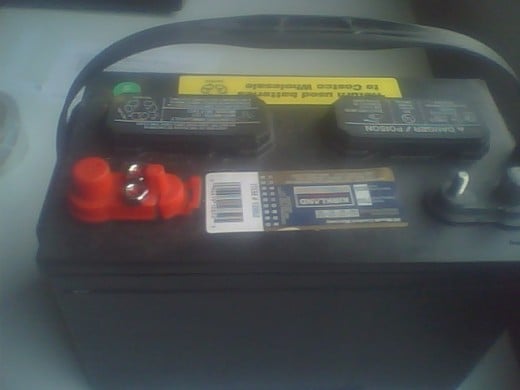- HubPages»
- Education and Science»
- Teaching»
- Lesson Plans
Lesson Plan-Renewable Energy Survival- Batteries

BATTERY TERMS
BATTERY: A device that usable electrical energy can be obtained by the conversion of chemical energy to electricity
LEAD-ACID BATTERY:A battery that has lead plates and Sulfuric Acid and is charged, mostly used for automotive uses. http://en.wikipedia.org/wiki/Lead%E2%80%93acid_battery
CHEMICAL REACTION: The transformation of certain products into a totally different product, by changing the chemical makeup. http://en.wikipedia.org/wiki/Chemical_reaction
RECHARGABLE BATTERY: A device that supplies a usable electrical current, but has to have an outside electrical source to charge the device first.
ANODE: an electrode in which electrons flow into the polarized device http://en.wikipedia.org/wiki/Anode#Battery_or_galvanic_cell_anode
CATHODE: an electrode in which electrons flow away from the polarized device http://en.wikipedia.org/wiki/Cathode
ELECTROLYTE: A substance that contains free ions that make the substance electrically conductive http://en.wikipedia.org/wiki/Electrolytes
VOLT: referring to electricity, it is the pressure or force http://en.wikipedia.org/wiki/Volt
AMP: Pertaining to the units of electrical current
WIRE: Strand of electrical current conductive material http://en.wikipedia.org/wiki/Wire
POLE: the anode or the cathode which are determined to be positive or negative
NEGATIVE and POSITIVE: referring to the pole of the battery, of which one would be negative and one would be positive. The flow of electrons travel from the negative pole to the positive. http://en.wikipedia.org/wiki/Electrical_polarity
GROUND: Return path of an electrical current
2012 and 2013 ENERGY GRID FAILURE
With the increasing solar activity of sun flares, heightened weather patterns and the possibility of other nations with EMP technology, there is a good chance that there will be times our nation will be without the electrical grid in some parts of the country.
Now is the time to have a renewable energy source hooked up, ready to go and even supplementing the income. The batteries are just one component to the renewable energy system, but knowledge of renewable energy can be of great advantage and even to the point of one's survival.
This information presented touches on the basics of the solar, thermal, wind and water power, along with some fringe science that electricity can be produced, but not highly recognized.
BATTERY
The technology of batteries is advancing to the point of having batteries for almost any purpose. The first batteries were the simple lead-acid batteries that are still used for the starting motors of cars, but now, batteries are used for thousands of purposes.
The basis for the batteries is that two dislike metals produce an electrical current between them by exchanging electrons. For this to happen, an electrolyte must be used to conduct the connection and transfer of ions between the two metals.
http://laurenswright.hubpages.com/hub/BUILDING-A-COPPER-ALUMINUM-BATTERY
The common flashlight batteries are made to be be used until the charge is gone, then get rid of the remains, either by discarding them or to recycle them. These are made of carbon, some type of metal and some electrolyte.
The new generation of batteries are getting more and more advanced, lasting longer and producing more power. NICd batteries are made to be repeatedly discharged and recharged without being damaged.
http://www.cap-xx.com/resources/reviews/batteries.htm
Battery banks, which are batteries linked together, are used for renewable systems for charging then the electricity is used as needed. Sometimes the electricity is converted from a battery bank of 12, 24 or 48 volts to another voltage, like 120 volts, with the use of an inverter, so that many household appliances could be made to function and operate.
WIRE
Wire is the electrical conductive strand that permit the transmit the electrons. The most common wire for electrical conductivity is copper because of its cost, the availability, its versatility and for its properties of conductivity. Wire also comes in different forms such as aluminum, aluminum-clad and steel. There have been problems with the aluminum wire in that the exposed ends corrode and have a build up of aluminum oxide that can heat up because of resistance and cause fires.
The wire comes in different gauges and ampere ratings. The service entrance wires for houses use a heavier gauge and amp rating, while low voltage door bells and the such use a low amp and wire size. The service entrance would use number 2, 1, 1/0, 2/0, 3/0, or 4/0 which would service from 95 amperes to about 195 amperes. The number 2 rating would be the smallest wire size of 95 amperes rating for the service entrance of the building or the house. The number 18 gauge would be used possibly for the door bell, while number 8, 10,12 and 14 could be used for the house appliances and lighting circuits. The Number 4 and 6 would be reserved for the heavier appliances and uses of 50 to 70 amperes.
There is a universal color coding of the wires that help the understanding of another persons work and later changes of the systems. The BLACK, RED AND BLUE wires are hot, while the white is the common or neutral wire and the green and bare copper wires are the grounding wires.
VOLTAGE
The batteries have electrochemical cells, of which each generates 1.5 to 2.0 volts of electricity. With a 1 1/2 volt battery, one cell is used, but with a 12 volt battery, the cells are interconnected with six to eight individual cells to produce the 12 to 13.8 volts.
The electrical cells can be linked together to produce different voltages. The appliances, machinery and common tools are usually made to use 12, 24, 48 or 120 volts, so the battery voltages can either be multiplied by 1.5 per cell or a device, called an inverter, to convert the voltages to the proper and usable voltages.
CHEMICAL REACTION
The chemical reactions that the batteries produce react to make electricity. The reaction could be a displacement, replacement, double displacement or acid-base reaction, depending on the substances that are used in combining to make the electricity.
Many different chemicals and substances can be used to make the chemical reaction to produce electricity, but some substances are better suited and functional than others. With the lead-acid car battery, it serves the purpose of turning the starting motor, but it produces Hydrogen gas that can be explosive and dangerous. Some of the other substances, like mercury, has been determined as toxic, so the discarding of the discharged battery becomes a problem in the disposal because of toxicity..
http://www.chem.hawaii.edu/uham/bat.html
Renewable and Rechargable Batteries
The rechargeable deep cycle / discharge batteries are the ones that are used in the renewable energy fields because the batteries can be slowly discharged and are able to be recharged from the renewable energy systems. The car batteries are not usually functional for this because the car battery is designed to turn the starting motor with lots of force and power released at the same time, while a deep discharge battery used for renewable energy is designed to release the power and energy slowly.
With most renewable energy systems, the supply is not constant, as with the sun and the wind, so some way of storing the electricity is desired. This is where the deep cycle / discharge batteries are used to store the usable electricity until when desired. Also, with the water systems, the flow might be constant, but the usage of the electricity is not constant, so there are times when the demands of electricity would be more. The battery bank would be tapped to the extra electrical needs and demands during peak usage.
http://www.appropedia.org/Deep-cycle_lead-acid_batteries_for_renewable_energy_storage
LESSON PLAN; RENEWABLE ENERGY; BASIC INTRODUCTION
Please look at the Renewable Energy Lesson Plan for Basic Introduction:
http://laurenswright.hubpages.com/hub/Lesson-Plan-Renewable-Energy-Basic-Introduction












